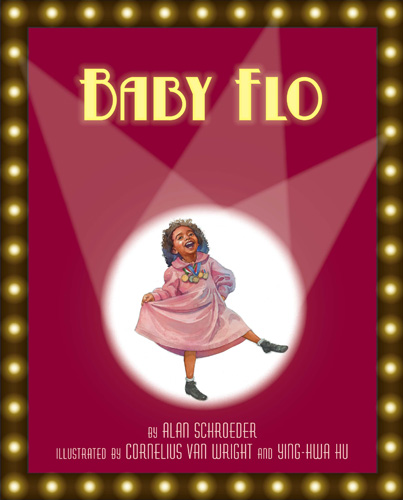24 Jun / Baby Flo by Alan Schroeder, illustrated by Cornelius Van Wright and Ying-Hwa Hu

 In a short introductory paragraph on the copyright page, author Alan Schroeder begins with a summary of what’s real and what’s been embellished “for storytelling purposes” in this vibrant title, because “[r]eliable information about [Baby Flo’s] early years is limited.” Schroeder is definitely speaking to parents before he embarks on his children’s story, his wry irony quite entertaining: Flo’s last name, Mills, was given to her at age 4, he explains, because “[h]er parents presumably did not think that a black woman could make it in show business with the last name of Winfrey.” I’m still chuckling, exclamations and all!
In a short introductory paragraph on the copyright page, author Alan Schroeder begins with a summary of what’s real and what’s been embellished “for storytelling purposes” in this vibrant title, because “[r]eliable information about [Baby Flo’s] early years is limited.” Schroeder is definitely speaking to parents before he embarks on his children’s story, his wry irony quite entertaining: Flo’s last name, Mills, was given to her at age 4, he explains, because “[h]er parents presumably did not think that a black woman could make it in show business with the last name of Winfrey.” I’m still chuckling, exclamations and all!
“Straight up: Florence was a remarkable child, and that’s a fact,” Schroeder opens. Born just before the 20th century to a family living in one of Washington, DC’s poorest neighborhoods, Florence Mills could sing and dance practically from birth.
She wowed the crowds by age 3, making her stage debut at the Bijou Theatre. By age 6, she was winning medals for her cakewalk, “a high-stepping, high-strutting, look-at-me sort of dance people couldn’t get enough of.” By 1903, at the ripe old age of 7, Baby Florence had her name up in bright lights … and here the story ends, but her path from hometown baby girl to international star is clear.
The “Author’s Note” at book’s end includes Baby Flo’s career into adulthood, through her too-early death at just 31. Black-and-white photographs are also included – including one that shows the overflowing Harlem streets filled with mourners at her funeral. Had she not been born in an era controlled by racial prejudice, she “would have been regarded as one of the half dozen greatest theatrical performers of the twentieth century,” according to one of her producers. That no film footage nor vocal recordings of her suvives – at least none have surfaced – seems a double artistic tragedy.
What was sadly not preserved on film, is abundantly presented on the page: the veteran husband-and-wife team of Cornelius Van Wright and Ying-Hwa Hu (who made Karen Chinn’s Sam and the Lucky Money such a visual delight) has clearly captured the vivacious spirit of the gifted young performer.
The illustrations are an enchanting enhancement to Schroeder’s words. Baby Flo’s joy is palpable. Her impromptu audiences, filled with faces shocked and surprised by her magnetic performances, wear their wonder with such utter openness that you can almost hear the little girl’s precocious voice. Her tiny toddler body looking out with frightened wide eyes from the expansive open stage of the Bijou Theater is a touching reminder of her tender age. The final spread at story’s end as the theater marquis lights up with Baby Flo’s name, is a gleeful hop-skip-and-jumping dance of father and still-small daughter, just beckoning readers to join in. Forget American Idol or [insert country]’s Got Talent … here’s a true icon to applaud and celebrate.
Readers: Children
Published: 2012

Summary of the story of Baby Flo makes me curious to read it.